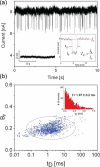Highly Sensitive, Mechanically Stable Nanopore Sensors for DNA Analysis
- PMID: 20098720
- PMCID: PMC2808638
- DOI: 10.1002/adma.200803786
Highly Sensitive, Mechanically Stable Nanopore Sensors for DNA Analysis
Figures






Similar articles
-
Nanopore-based sensors for DNA sequencing: a review.Nanoscale. 2024 Oct 17;16(40):18732-18766. doi: 10.1039/d4nr01325e. Nanoscale. 2024. PMID: 39295590 Review.
-
Detection and Separation of DNA and Silver Nanoparticles Using a Solid-State Nanopore.ACS Omega. 2023 May 9;8(20):17682-17688. doi: 10.1021/acsomega.3c00152. eCollection 2023 May 23. ACS Omega. 2023. PMID: 37251189 Free PMC article.
-
Precise electrochemical fabrication of sub-20 nm solid-state nanopores for single-molecule biosensing.J Phys Condens Matter. 2010 Nov 17;22(45):454128. doi: 10.1088/0953-8984/22/45/454128. Epub 2010 Oct 29. J Phys Condens Matter. 2010. PMID: 21339614
-
The application of single molecule nanopore sensing for quantitative analysis.Chem Soc Rev. 2022 May 23;51(10):3862-3885. doi: 10.1039/d1cs00988e. Chem Soc Rev. 2022. PMID: 35506519 Review.
-
Key Parameters That Determine the Magnitude of the Decrease in Current in Nanopore Blockade Sensors.Nano Lett. 2021 Nov 24;21(22):9374-9380. doi: 10.1021/acs.nanolett.1c01855. Epub 2021 Nov 2. Nano Lett. 2021. PMID: 34726925
Cited by
-
The effects of geometry and stability of solid-state nanopores on detecting single DNA molecules.Nanotechnology. 2015 Jan 30;26(4):044001. doi: 10.1088/0957-4484/26/4/044001. Epub 2015 Jan 5. Nanotechnology. 2015. PMID: 25556317 Free PMC article.
-
Fabrication and characterization of solid-state nanopore arrays for high-throughput DNA sequencing.Nanotechnology. 2012 Sep 28;23(38):385308. doi: 10.1088/0957-4484/23/38/385308. Epub 2012 Sep 5. Nanotechnology. 2012. PMID: 22948520 Free PMC article.
-
Sub-5 nm Silicon Nanopore Sensors: Scalable Fabrication via Self-Limiting Metal-Assisted Chemical Etching.ACS Appl Mater Interfaces. 2025 Feb 12;17(6):9047-9058. doi: 10.1021/acsami.4c19750. Epub 2025 Jan 30. ACS Appl Mater Interfaces. 2025. PMID: 39882662 Free PMC article.
-
Single-Entity Detection With TEM-Fabricated Nanopores.Front Chem. 2021 May 7;9:664820. doi: 10.3389/fchem.2021.664820. eCollection 2021. Front Chem. 2021. PMID: 34026729 Free PMC article. Review.
-
Fabrication and Applications of Solid-State Nanopores.Sensors (Basel). 2019 Apr 20;19(8):1886. doi: 10.3390/s19081886. Sensors (Basel). 2019. PMID: 31010038 Free PMC article. Review.
References
-
- Li J, Stein D, McMullan C, Branton D, Aziz MJ, Golovchenko JA. Nature. 2001;412:166. - PubMed
-
- Li J, Gershow M, Stein D, Brandin E, Golovchenko JA. Nat. Mater. 2003;2:611. - PubMed
-
- Storm AJ, Chen JH, Ling XS, Zandbergen HW, Dekker C. Nat. Mater. 2003;2:537. - PubMed
-
- Chang H, Kosari F, Andreadakis G, Alam MA, Vasmatzis G, Bashir R. Nano Lett. 2004;4:1551.
Grants and funding
LinkOut - more resources
Full Text Sources
Other Literature Sources

